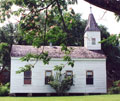
Many historic churches in Texas are slowly crumbling apart and their chances of survival don’t have a prayer.
A Texas A&M University architecture professor hopes to change that scenario.
Anat Geva, associate professor of architecture, is participating in a project aimed at locating, documenting and preserving historic church buildings and houses of worship in Texas.
Officially titled the Texas Sacred Places Project, the program was launched in 2007 as a collaboration initiative of several groups — among them historians, preservationists, professors, architects and the Texas Historical Commission — who are determined to ensure that some of the state’s oldest churches literally aren’t blown to dust.
Project members will meet in Langford A217 at the Texas A&M College of Architecture from 10 a.m. – 3 p.m. Feb. 28 to discuss posting an interactive database of historic places of worship on the Internet.
“There are numerous historic churches that are in danger of not surviving,” Geva explains.
“Most of these have not been used for many years. Our focus right now is twofold: to identify and document these churches, and then to find ways to help preserve them.”
Geva and others are working with Partners in Sacred Places, a Philadelphia-based organization that is dedicated to promoting the stewardship of historic religious properties. A nonprofit organization, it coordinates workshops and helps to raise funds for the preservation work.
While many of today’s worship places could be classified as “mega-churches” that occupy two city blocks and can seat 10,000 or more members, the ones Geva hopes to preserve are far different. Most are humble in scale and represent the culture of each particular area. Some were established by German immigrants or other European settlers, while others are Catholic in origin.
“So preserving them is in a way preserving the culture of the time,” she explains.
Geva is studying how immigrants transplanted their concepts of sacred architecture on Texas soil. She has examined seven churches built by European immigrants during the second half of the 19th century in south Central Texas. They include Wesley Brethren Church, Wesley (Austin County, 1866), built by Czech immigrants; Bethlehem Lutheran Church, Round Top (Fayette County, 1866-67), built by immigrants from the region of Alsace, France; and St. Paul’s Lutheran Church, Serbin (Lee County, 1871), built by the Wends who immigrated from Lusatia, Germany.
Also, The Nativity of the Blessed Virgin Mary Church, Cestohowa (Karnes County, 1877), built by Polish immigrants; The Gethsemane Lutheran Church, Austin (Travis County, 1883), built by Swedish immigrants; and Bastrop Christian Church, Bastrop (Bastrop County, 1895), built by German immigrants.
In her study, Geva showed that these churches retained the form of the congregations’ homeland church and did not “succumb to the local forces even in extreme conditions such as the hot summers of Texas. These buildings serve as the symbol of the community’s culture and heritage linking the present with the past.”
Geva said the group has agreed to discuss one point that needs clarification: what exactly is meant by “historic?”
“Works of a religious nature can mean different things to different people,” she notes. “Does historic mean within the past century or beyond it? That is one question we are asking ourselves.
“What we know for sure is that these churches at one time had an impact on the people of their area. If we lose these buildings, we lose part of history and perhaps a piece of our own heritage.
“That would be a terrible loss for everyone.”






